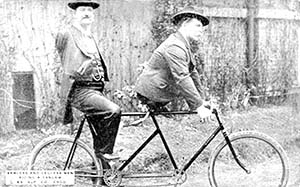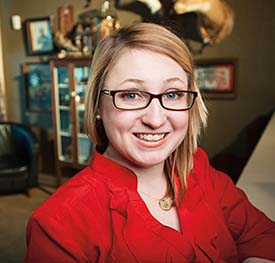 |
 |
| current issue |  |
past issues |  |
send a letter/news |  |
address update |  |
advertise |  |
about us |  |
alumni home |
Beyond Borders
Page 3 of 3
Previous
The Aristocrats Charles B. Tripp, who was born without arms, managed to support his mother and sister by doing carpentry with his feet, until he joined P.T. Barnum's circus in 1872. "You could get a job if you were a freak back then," says Emma Baillargeon '09, "but you could make more money by being a freak." Between 1840 and 1930, many people with noticeable anatomical differences gravitated toward the museums, circuses, and carnivals where the freak show—the focus of Baillargeon's master's thesis in liberal studies—was considered a popular and legitimate form of entertainment. Some, including Tripp, who became known as the Armless Wonder, spent their entire lives performing. Others made a pile of money and settled down, like the conjoined twins Chang and Eng Bunker, from Siam (now Thailand), who bought land in North Carolina, married two sisters, and raised 21 children. Baillargeon has found that freak show performers reaped more than just financial benefits. They found solidarity not only among their fellow freaks, but also within the tight circle of circus workers, who had their own lingo and code of behavior for dealing with outsiders, or "rubes." Shouting "Hey, Rube!" would immediately bring the entire crew to the defense of any co-worker who felt threatened.
In high school, Baillargeon got a taste of what it's like be ostracized. She didn't fit in because she liked punk rock, but she made new friends at weekend concerts. "I found that I was marginal," she says, "but I found solidarity in that marginality." Her art teacher, Annette Blake '93, introduced her to the controversial work of Diane Arbus, who photographed "deviant and marginal" people. "Most people go through life dreading they'll have a traumatic experience," Arbus once wrote. "Freaks were born with their trauma. They've already passed their test in life. They're aristocrats." It's a reality of the human condition, notes Baillargeon, that our bodies, and hence our social identities, are fragile. "At any moment we could easily become maimed and in turn, become a freak or disabled person, ourselves," she says, and part of what attracts us is seeing how others have "passed the test." The stage name "Armless Wonder" captures both the loss of normalcy inherent in deformity and the triumph of succeeding not just in spite of—but because of—that loss. "Charles Tripp could do everything with his feet," says Baillargeon. "Thread a needle, drink a cup of tea. To me, that's what a 'freak' is—someone who conquers life." |
blog comments powered by Disqus



